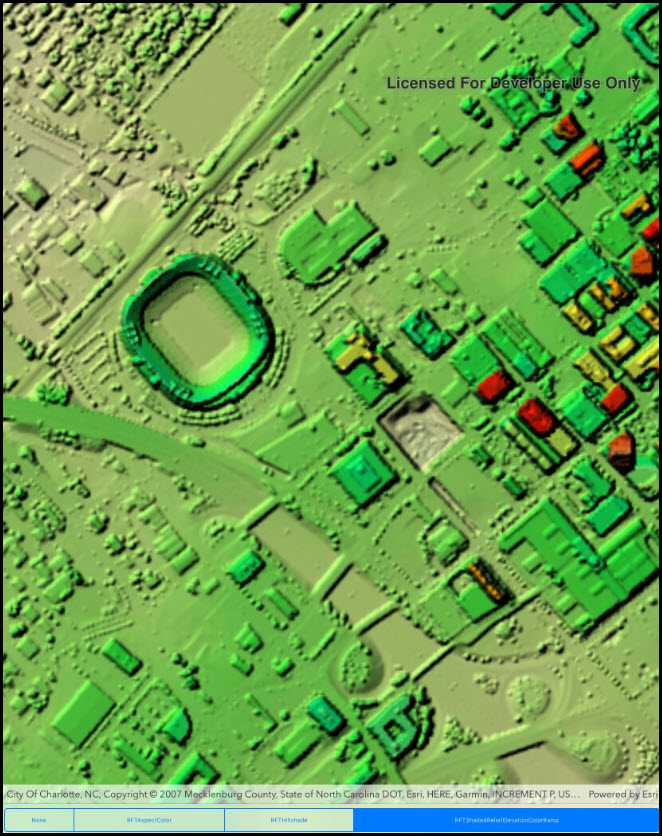Display a raster on a map and apply different rendering rules to that raster.

Use case
Raster images whose individual pixels represent elevation values can be rendered in a number of different ways, including representation of slope, aspect, hillshade, and shaded relief. Applying these different rendering rules to the same raster allows for a powerful visual analysis of the data. For example, a geologist could interrogate the raster image to map subtle geological features on a landscape, which may become apparent only through comparing the raster when rendered using several different rules.
How to use the sample
Run the sample and use the drop-down menu at the top to select a rendering rule.
How it works
- Create an
ImageServiceRasterusing a URL to an online image service. - After loading the raster, use
imageServiceRaster.ServiceInfo.RenderingRuleInfosto get a list ofRenderingRuleInfosupported by the service. - Choose a rendering rule info to apply and use it to create a
RenderingRule. - Create a new
ImageServiceRasterusing the same URL. - Apply the rendering rule to the new raster.
- Create a
RasterLayerfrom the raster for display.
Relevant API
- ImageServiceRaster
- RasterLayer
- RenderingRule
About the data
This raster image service contains 9 LAS files covering Charlotte, North Carolina's downtown area. The lidar data was collected in 2007. Four Raster Rules are available for selection: None, RFTAspectColor, RFTHillshade, and RFTShadedReliefElevationColorRamp.
Additional information
Image service rasters of any type can have rendering rules applied to them; they need not necessarily be elevation rasters. See the list of raster function objects and syntax for rendering rules in the ArcGIS REST API documentation.
Tags
raster, rendering rules, visualization
Sample Code
// Copyright 2017 Esri.
//
// Licensed under the Apache License, Version 2.0 (the "License"); you may not use this file except in compliance with the License.
// You may obtain a copy of the License at: http://www.apache.org/licenses/LICENSE-2.0
//
// Unless required by applicable law or agreed to in writing, software distributed under the License is distributed on an
// "AS IS" BASIS, WITHOUT WARRANTIES OR CONDITIONS OF ANY KIND, either express or implied. See the License for the specific
// language governing permissions and limitations under the License.
using System;
using System.Collections.Generic;
using System.Threading.Tasks;
using Esri.ArcGISRuntime.ArcGISServices;
using Esri.ArcGISRuntime.Geometry;
using Esri.ArcGISRuntime.Mapping;
using Esri.ArcGISRuntime.Rasters;
using Esri.ArcGISRuntime.UI.Controls;
using Foundation;
using UIKit;
namespace ArcGISRuntime.Samples.RasterRenderingRule
{
[Register("RasterRenderingRule")]
[ArcGISRuntime.Samples.Shared.Attributes.Sample(
name: "Raster rendering rule",
category: "Layers",
description: "Display a raster on a map and apply different rendering rules to that raster.",
instructions: "Run the sample and use the drop-down menu at the top to select a rendering rule.",
tags: new[] { "raster", "rendering rules", "visualization" })]
public class RasterRenderingRule : UIViewController
{
// Hold references to UI controls.
private MapView _myMapView;
private UILabel _selectionLabel;
private UIBarButtonItem _changeRuleButton;
// Hold a reference to a read-only list for the various rendering rules of the image service raster.
private IReadOnlyList<RenderingRuleInfo> _renderRuleInfos;
// URL for the image server.
private readonly Uri _myUri = new Uri("https://sampleserver6.arcgisonline.com/arcgis/rest/services/CharlotteLAS/ImageServer");
public RasterRenderingRule()
{
Title = "Raster rendering rule";
}
private async void Initialize()
{
// Set up the map with basemap.
_myMapView.Map = new Map(BasemapStyle.ArcGISTopographic);
// Load the rendering rules for the raster.
await LoadRenderingRules();
// Apply the first rendering rule
SelectRenderingRule(_renderRuleInfos[0]);
}
private async Task LoadRenderingRules()
{
// Create a new image service raster from the Uri.
ImageServiceRaster imageServiceRaster = new ImageServiceRaster(_myUri);
try
{
// Load the image service raster.
await imageServiceRaster.LoadAsync();
// Get the ArcGIS image service info (metadata) from the image service raster.
ArcGISImageServiceInfo arcGISImageServiceInfo = imageServiceRaster.ServiceInfo;
// Get the full extent envelope of the image service raster (the Charlotte, NC area).
Envelope myEnvelope = arcGISImageServiceInfo.FullExtent;
// Define a new view point from the full extent envelope.
Viewpoint viewPoint = new Viewpoint(myEnvelope);
// Zoom to the area of the full extent envelope of the image service raster.
await _myMapView.SetViewpointAsync(viewPoint);
// Get the rendering rule info (i.e. definitions of how the image should be drawn) info from the image service raster.
_renderRuleInfos = arcGISImageServiceInfo.RenderingRuleInfos;
}
catch (Exception e)
{
new UIAlertView("Error", e.ToString(), (IUIAlertViewDelegate) null, "OK", null).Show();
}
}
private void SelectRenderingRule(RenderingRuleInfo renderingRuleInfo)
{
// Create a new rendering rule from the rendering rule info.
RenderingRule renderingRule = new RenderingRule(renderingRuleInfo);
// Create a new image service raster.
ImageServiceRaster imageServiceRaster = new ImageServiceRaster(_myUri)
{
// Set the image service raster's rendering rule to the rendering rule created earlier.
RenderingRule = renderingRule
};
// Create a new raster layer from the image service raster.
RasterLayer rasterLayer = new RasterLayer(imageServiceRaster);
// Clear the existing layer from the map.
_myMapView.Map.OperationalLayers.Clear();
// Add the raster layer to the operational layers of the map view.
_myMapView.Map.OperationalLayers.Add(rasterLayer);
// Update the label.
_selectionLabel.Text = $"Rule \"{renderingRuleInfo.Name}\" selected.";
}
private void ChangeRenderingRule_Clicked(object sender, EventArgs e)
{
// Create the alert controller with a title.
UIAlertController alertController = UIAlertController.Create("Choose a rendering rule", "", UIAlertControllerStyle.Alert);
// Add actions for each rendering rule.
foreach (RenderingRuleInfo ruleInfo in _renderRuleInfos)
{
alertController.AddAction(UIAlertAction.Create(ruleInfo.Name, UIAlertActionStyle.Default, action => SelectRenderingRule(ruleInfo)));
}
// Show the alert.
PresentViewController(alertController, true, null);
}
public override void ViewDidLoad()
{
base.ViewDidLoad();
Initialize();
}
public override void LoadView()
{
// Create the views.
View = new UIView {BackgroundColor = ApplicationTheme.BackgroundColor};
_myMapView = new MapView();
_myMapView.TranslatesAutoresizingMaskIntoConstraints = false;
_changeRuleButton = new UIBarButtonItem();
_changeRuleButton.Title = "Change rendering rule";
UIToolbar toolbar = new UIToolbar();
toolbar.TranslatesAutoresizingMaskIntoConstraints = false;
toolbar.Items = new[]
{
new UIBarButtonItem(UIBarButtonSystemItem.FlexibleSpace),
_changeRuleButton,
new UIBarButtonItem(UIBarButtonSystemItem.FlexibleSpace)
};
_selectionLabel = new UILabel
{
Text = "No rendering rule selected.",
AdjustsFontSizeToFitWidth = true,
TextAlignment = UITextAlignment.Center,
BackgroundColor = UIColor.FromWhiteAlpha(0, .6f),
TextColor = UIColor.White,
Lines = 1,
TranslatesAutoresizingMaskIntoConstraints = false
};
// Add the views.
View.AddSubviews(_myMapView, _selectionLabel, toolbar);
// Lay out the views.
NSLayoutConstraint.ActivateConstraints(new[]
{
_myMapView.TopAnchor.ConstraintEqualTo(View.SafeAreaLayoutGuide.TopAnchor),
_myMapView.LeadingAnchor.ConstraintEqualTo(View.LeadingAnchor),
_myMapView.TrailingAnchor.ConstraintEqualTo(View.TrailingAnchor),
_myMapView.BottomAnchor.ConstraintEqualTo(toolbar.TopAnchor),
toolbar.BottomAnchor.ConstraintEqualTo(View.SafeAreaLayoutGuide.BottomAnchor),
toolbar.LeadingAnchor.ConstraintEqualTo(View.LeadingAnchor),
toolbar.TrailingAnchor.ConstraintEqualTo(View.TrailingAnchor),
_selectionLabel.TopAnchor.ConstraintEqualTo(View.SafeAreaLayoutGuide.TopAnchor),
_selectionLabel.LeadingAnchor.ConstraintEqualTo(View.LeadingAnchor),
_selectionLabel.TrailingAnchor.ConstraintEqualTo(View.TrailingAnchor),
_selectionLabel.HeightAnchor.ConstraintEqualTo(40)
});
}
public override void ViewWillAppear(bool animated)
{
base.ViewWillAppear(animated);
// Subscribe to events.
_changeRuleButton.Clicked += ChangeRenderingRule_Clicked;
}
public override void ViewDidDisappear(bool animated)
{
base.ViewDidDisappear(animated);
// Unsubscribe from events, per best practice.
_changeRuleButton.Clicked -= ChangeRenderingRule_Clicked;
}
}
}